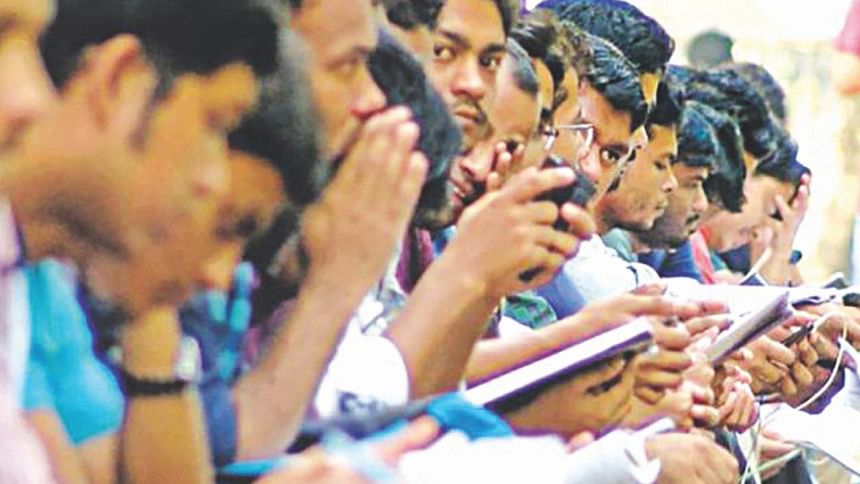How much has the youth gained from growth?

If one asks owners or chief executives of companies and organisations to single out one difficulty that they face, a chorus of voices will respond in unison: lack of skilled human resources. On the other hand, if one investigates into the one prominent challenge for the economy at this very moment, many would point to the lack of employment opportunities for the youth.
Bangladesh is a country of about 160 million people. The share of population within 15-24 years is close to 20 percent and the median age of its people are a little over 26 years. Thus Bangladesh is uniquely positioned to reap the benefits of this "demographic dividend". But how many of them have the opportunity to enter the labour market? According to official statistics, overall unemployment rate is 4.2 percent in Bangladesh. However, youth unemployment rate is 10.6 percent. What do these young people do? Are they studying? Are they going through training? No, not all of them. The share of youth from within the total youth population in the country who are neither in education, nor in employment or training (NEET) is 29.8 percent.
Bangladesh's economic growth has been consistently high during the past decade. In fiscal year 2018, it reached a record high of 7.86 percent, a growth that has only been matched by China and India—two economic giants. However, our economic growth has not kept up with the rate of job creation for our young workforce. These youth could be in NEET due to the lack of quality jobs or they could be struggling to be in education and training. Ironically, young people who are more highly educated face greater problems in securing a job. According to the Labour Force Survey 2016-17 unemployment among the youth who have received secondary level education is as high as 28 percent. Unemployment rate among those who have received tertiary level education is 13.4 percent. Higher unemployment among the educated youth is both due to insufficient regular salaried jobs and their unwillingness to join low paid informal jobs. In Bangladesh more than 80 percent of jobs are in the informal and unorganised sectors which are low paid. Whatever the reason is, the reality is that education is not empowering the youth with the right skills-set to be employable in the job market. Thus the country is being deprived of much contribution from this large workforce since the full potential of this young population remains unutilised.
But we have to recognise that youth unemployment is a multidimensional problem. If not addressed, the problem can become a threat to social, economic and political stability of a country. Not only can it lead to demoralisation, depression, loss of self-confidence and social exclusion but it also brings stress to societies and families. Research has shown that crime rates are positively related to youth unemployment.
The solution to such high youth unemployment lies in the very structure of the economy and the education system. The structure of employment generation in Bangladesh is such that the industrial sector accounts for 20.4 percent, while the service sector creates 39 percent of total employment. The rest 40.6 percent employment is in the agriculture sector, even though agriculture's share in GDP is less than 14 percent. So non-agricultural sectors have to create more opportunities for employment. Though the manufacturing sector has potential for higher opportunities, the sector is increasingly feeling the pressure of being automated to increase productivity and remain competitive. This means that labour intensity will decline. But if the scale of operations is expanded, there may be need for more workers. Without skills development and training, the existing workforce will not be able to cater to the demand of the newly emerging job market.
Another prospective area is small and medium enterprises. Recently, a number of start-ups have emerged which is another source of employment. Innovative and dynamic young people are creating jobs for others instead of looking for secure jobs for themselves. These have to be backed by favourable policy measures including access to finance, better infrastructure, improved logistics and fiscal incentives. The government has to formulate concrete plans so that rapid growth is accompanied by high quality and more productive employment.
In the face of low employability of our young workforce the gap is being fulfilled by hiring skilled people from neighbouring countries. So, quality of education and appropriate skills are basic requirements for increased opportunity for the youth. Investment in education sector must be raised from its current level of only two percent of the GDP. Also, the private sector has to provide skills development by offering apprenticeships and setting up training institutes. Experiences in other countries show that technical and vocational training increases the possibility of finding jobs for both the educated and uneducated unemployed. Sector specific skills and knowledge are needed for developing their capability, improving productivity and building entrepreneurship.
During the latter half of the 20th Century, East Asian countries were able to take advantage of their demographic dividend and grow very fast. At present in many developed countries, people are aging fast resulting in economic slowdowns in those countries. In Bangladesh, if the youth workforce is engaged in economic activities of the country in a well-coordinated manner they can contribute to increased income, more savings, higher productivity and faster economic growth. With rapid economic growth and several opportunities emerging, a change is on the horizon for Bangladesh. Let the youth be a part of this positive change.
Fahmida Khatun is the Executive Director of Centre for Policy Dialogue (CPD).





Comments